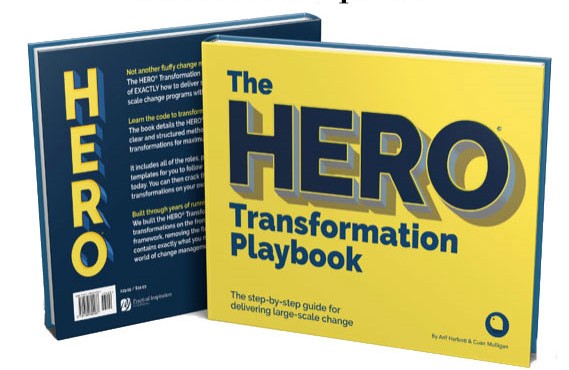In the next couple of posts I shall share a review of the HERO Transformation Playbook. The authors invited me to read the book and to write down my impressions. These are honest, mixed (good things- less good things) and aim at opening up the content for those of you who are in a transformation process, either as internal project manager or as external consultant. This post covers part 1 of the book….
HERO, what it stands for and how you can use it….
In the introduction, the authors present the HERO concept. HERO stands for Hypothesis – Execution – Results Obtained. Besides defining their basic concept they substantiate its value for the (high-level) practical user. And this is where I got puzzled. I almost stopped reading any further, but afterwards I am glad I persisted till the very end of the book. The section is not only content-wise food for discussion; also the format, keeping the middle between powerpoint-like slogans and well-written text leans itself for readers to get disappointed at a certain point. “Is that all?” one would be tempted to ask, while the real stuff has yet to come. The format and approach are both pretty risky and may evoke mixed appreciations in the reader’s mind.
Just at a time the PowerPoint-like visuals are becoming a bit too much, one comes across a substantiated part that is very worthwhile. I had this mixed experience more than once while reading the book. It may have to do with the heterogenous target audience: on one hand the C-level functions for whom general principles like the ones in section 1 are very much OK; on the other hand the technical transformation leader, who is in search of tools, practical hints, guidelines etc… I have perceived the book’s section 2 and 3 as been written mainly with the latter in view, while the first section is more for the C’s.
Above all “The Hero Transformation Playbook” is a project-oriented book. You can use it as a manual for managing large transformation projects. The many goodies one can download from the website also support this target. Templates, schedules, checklists: everything is there to support a transformation project. The book is written by technical specialists for people who will approach the transformation as a logical process. “Soft” aspects are hardly mentioned in the book and clearly put in second place in a transformation process. Moreover the authors claim being different in not considering the “soft” aspects of change. They seem to suggest that “soft aspects” are either trivial or one of the main reasons companies lose time, energy and money in their transformation. The authors want to pay attention to it these soft factors when these elements show up as “blockers”. So first there must be a visible or tangible resistance, and then people will tackle that resistance. Commonly accepted concepts like “buy-in”, “mindset” are hardly covered or mentioned though, and that is a pity.
The story is not the full story…
I cannot sufficiently appreciate the impact of an early “buy in” in a change process. Moreover, it is essential to success, it is widely believed. This “buy-in” is best realized before we start the change, as later on it will be only harder to tackle. The authors seem to dispute this; on the other hand, they point out that many financial efforts by companies do not really lead to results and that their method is a better guarantee to achieve success. The C functions that will read this book will then feel delighted by the measurables, the enterprise value etc… But who will eventually get people cross the mental line? This answer remains unanswered, except for a referral to some other resources.
Besides this ,I also found some more delightful paragraphs in this first section. The chapter on “roles & key skills” in particular is to be mentioned; it is very well elaborated and particularly valuable for the practical user. The chapter on “assessing a transformation for possible success” will also be appreciated.
And yes, at a certain point the authors also agree that a transformation must be “compelling”, and must appeal to “imagination” and create energy among the stakeholders. A reassurance in the light of my earlier thoughts, but also a confirmation that the authors struggle a bit with a duality throughout the book: on the one hand they want to explain a transformation process factually and rationally, so that it doesn’t suffer from “soft change approaches”, but on the other hand they seem to recognize that “soft” approaches will be needed in order to make their HERO-method effective.
Takeaway from part 1
The first part was named “introduction” by the authors; it is much more than an introduction however and covers the “essentials” or “building blocks” of their method. Interesting and innovative ideas can be found, together with some arguable passages that will make many a change professional frown. A bumpy reading route.

